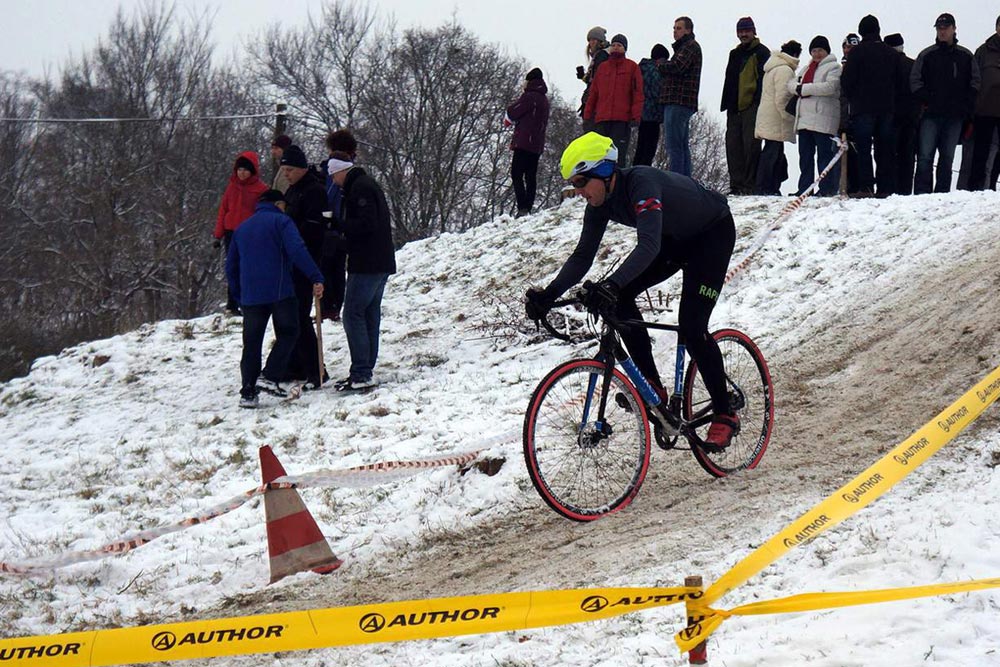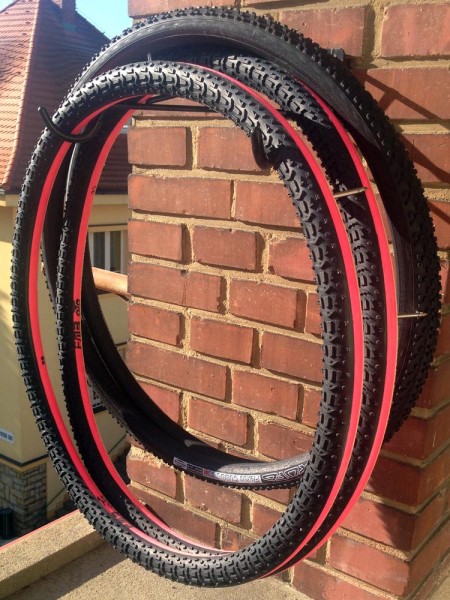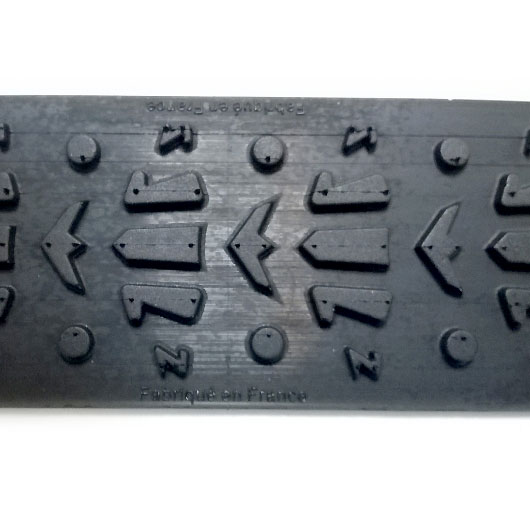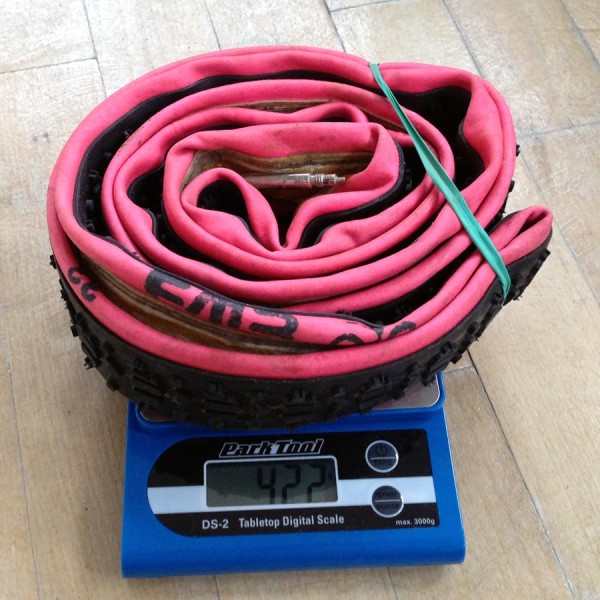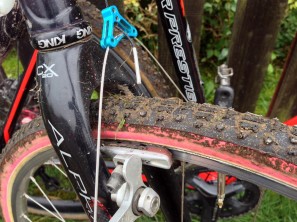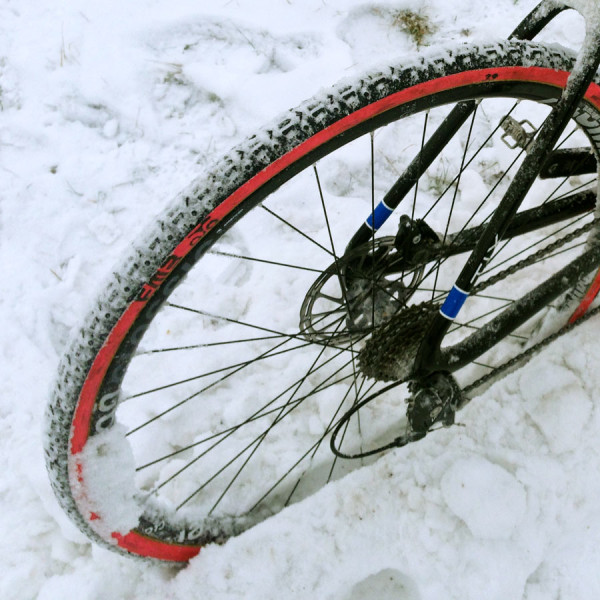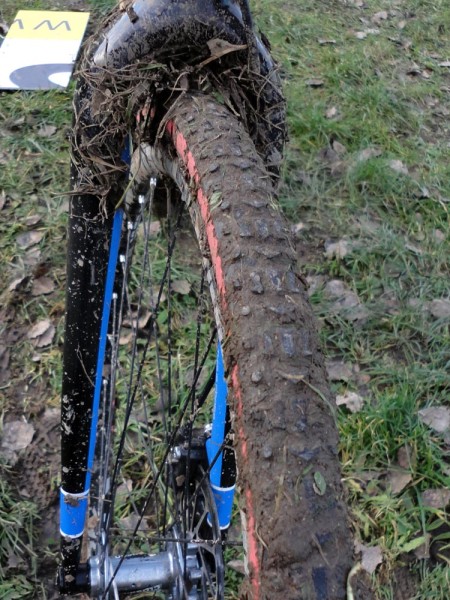After having chatted with husband/mechanic Mark Legg and a local colleague helping Compton on the cyclocross World Cup circuit here in Europe last year, we were curious to know more about those pink sidewalled tires. Then this season when we heard that longtime Dugast fan Jeremy Powers had made the switch to the same tires, we were set on finding out more. So we got in touch with François Marie of FMB (that’s François Marie Boyaux which essentially means tubulars made by Marie), and he was happy to make us a pair of tires to test. That’s right in that pretty much all of FMBs tires are made-to-order, and that in a company with just a few employees the namesake of the company is still making tires in their very traditional methods. We had a set of the all-conditions SSC Slalom cross tubulars and race-testing them in our regional European races from the dry early season, through a bit of mud, and into the snow. Roll past the break to see how much they weighed, how they were to work with, and how they performed through the whole season…
Weights & Tech
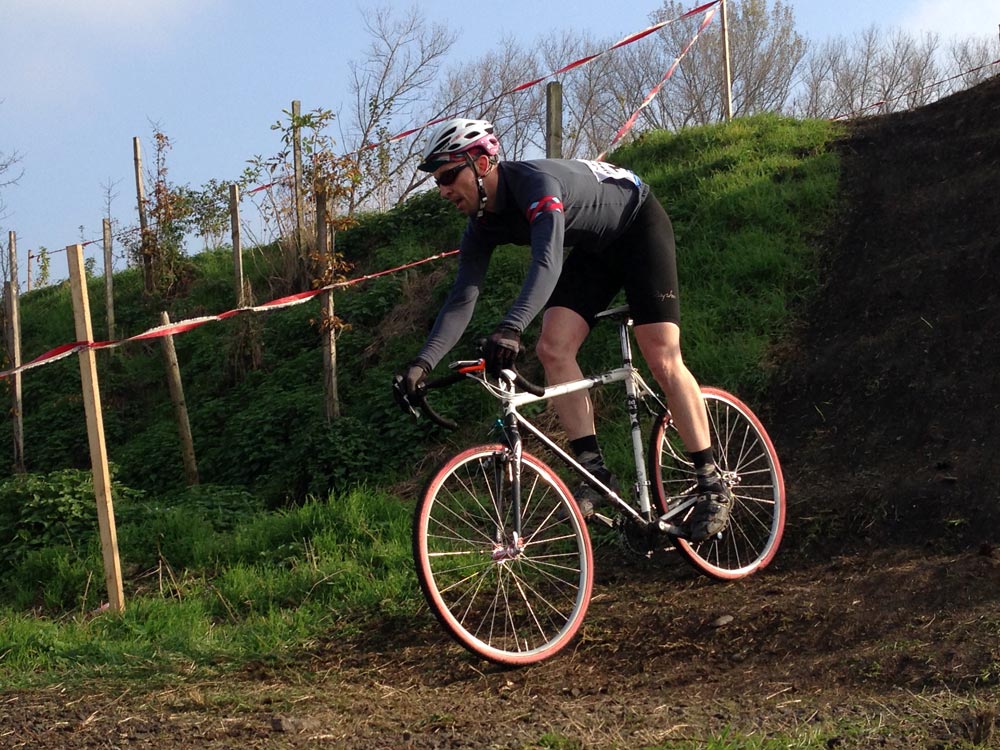
Outside of cyclocross, FMB is probably best known as a brand for the fat road tires they have been supplying to the ProTour teams tackling the cobbles of the spring classics for almost ten years, but we were first interested in their supple cotton tires for cross racing. The tires that Marie and his team put together for us were a set of the Slalom tires in a 33mm casing with the extra Pro pink sidewall reinforcement. (We’ve since seen some interesting green Pro cross variants.)
The Slalom tread design was developed a few years ago in cooperation with multi-US champion Katie Compton to provide a tire designed to roll fast, yet have the bite to dig into soft and loose technical terrain. The tread uses large densely packed arrow-shaped lugs down the center for fast rolling, which open towards the edge of the tire and include tiny Zs from the FMB Super Mud for the last line of cornering traction in loose conditions. The tires have an all-cotton casing made in-house by FMB and latex inner tubes.
All FMB tires have sidewalls treated with latex to protect their cotton construction from water infiltration, and thus do not need the extra aqua-sealing typical of most elite-level cyclocross tubulars that often has to be repeatedly reapplied. The Pro series FMB tires stand out with an additional thick latex sidewall layer that both offers further water resistance and abrasion resistance, but also gives some stability to the sidewall while still allowing the overall casing to remain flexible. The added protection is a big benefit to anyone who is regularly pressure washing their bikes, but also means the tires stand up longer to the abuse of cyclocross riding and racing, especially when ruts are involved. Speaking to Jeremy Power’s mechanic Tom Hopper at Cross Worlds, he spoke to how much time he saved in not having to seal the tires, but also to them being longer lasting. The added stability means that the Pro tires end up being run about 2psi lower than a similar tire to get a similar feel, and this results in a the tread being just a little bit more flexible while still having more confidence in hard cornering without squirm.
Our 33mm tires weighed in a 422g a piece, which while it is comparable to other cross tubulars is towards the higher end of tires we’ve tested this season (~370-430g.) The SSC Slaloms are available in 30, 33, and 34mm widths with either the basic natural latex sidewall protection for 77€ or in the Pro version with additional latex sidewall reinforcement for 109€. European customers can order from his French-only site, and everyone should be able to find a reasonably local supplier out the list of international distributors.
First Thoughts & Detailed Review
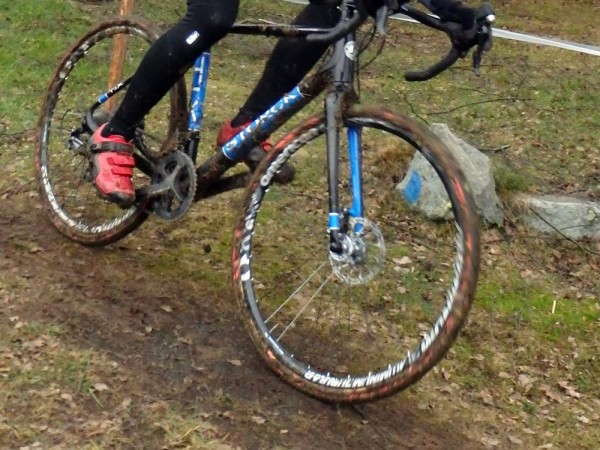
Gluing up the tires it was immediately apparent how much more supple these tires are than other production tubulars we have been working with this year. The pink latex sidewalls feel soft and pliable in the hand, and the tire stretched readily and rolled out to the side with only a few psi (at least 10psi lower than with a Challenge or Vittoria for comparison, or to the Tufos seen above that don’t twist at all due to their different construction.) The tires took glue well, and their stretchiness made them easy to mount. The tires mounted straightly to both wheelsets we glued them to, with no hops in the hand-glued tread.
Early season riding saw them ridden on a couple of canti-equipped steel bikes, and then towards the second half of the season on a couple of disc-brake carbon bikes and another steel bike. Our first couple of races were on bone dry tracks with a mix of hard-packed dirt, asphalt, and a lot of grass. The Slaloms rolled very well on the hard surfaces, but felt a bit slower than file treads on dry grass. The big knobs and reinforced sidewalls offered a lot of traction for cornering and did well on loose-over-hard surfaces, but the tires felt held back in the grass that made up a good bit of these two races.
As fall set in, dry cross courses began to disappear and the tires came into their own. The bulk of our season was held on tacky ground after morning dew or recent rains, with a few more rainy races, but for the most part the heavy mud and wet racing held off until December.
The tires really started to shine on damp loamy soil and the exposed dirt of off-cambers. One typically tough but fun technical course that includes sand, pine forest loam, and a mud pit turned out to be a perfect testing ground for the Slaloms as it was drier the usual. The tires showed versatility through slick clay, damp packed sand, damp grass, and the soft soil under freshly cleared leaf litter and pine needles. The tires picked up some of the wet dirt, but shed almost all of it on the off-camber sections and grass. The only thing left was some soil packed against the transition from tread to sidewall. I split the race on two bikes and being able to run slightly lower pressure than on a similar all-purpose tread made the tires stick a bit better on a couple of rooted off-camber turns, giving a bit of extra confidence each lap and let me carry speed into a short steep climb/run up.
The low pressures felt like they left my body less tense, and the boost in cornering confidence made me want to push harder through the turns. In the end I think the FMBs might have led me to a crash on a separate bike with my previous go-to tread, when I simply pushed those tires farther then they could handle. Sticking to soft and damp ground became reliable enough, that any time there was moisture on the ground the Slaloms became the favorite tire.
Towards the end of the season we had a few good snows, and in particular one race that was entirely on packed snow with some exposed ice. With the snow smoothing over the little bit of rough stuff on the course, I was able to drop pressures down to the very low 20s and come away with amazing traction. The tires grabbed the snow and ice, cleared quickly, remained stable cornering, and really only ever slipped on a high-speed tight sweeping turn of packed snow and ice over asphalt. The extra grip on the icy climbs and loose turns helped me to a season best finish, while I surprised a few guys who had been distancing me all season. To be fair, Shimano hydraulic disc brakes helped quite a bit as many racers had trouble with braking, but even then the discs let me leave braking to the last minute when the tires predictably gripped the snow and off-cambers. The only other time I remember having similar confidence on ice and snow had been training with file treads on the Tabor World Cup course when it was iced-over several years ago. This time I got the sense that the extra stability of the Pro sidewall was really what made the difference.
The Slaloms weren’t all flawless though. The little Zs derived from the Super Muds gave me the confidence to give them a shot on a couple of heavy mud courses, one of which included a lot of slogging wet grass. While the tires had cleared themselves on a course with muddy sections (less than half muddy), when the whole course had mud the densely spaced center tread packed up in half a lap and stayed that way. Traction was OK for a while, but as more grass got packed in between the knobs they began to slip more and more. Cornering traction remained acceptable and the wider spaced edges stayed open a bit more, but straight lines in the mud were pretty much a slip-and-slide. Without a pit team to constantly clean the tires and the mud build-up on the frame, I swapped out mid-race to a proper mud tire, which didn’t magically eliminate slipping, but cleared enough to stay consistent the rest of the race. On the other race that was a bit wetter, and less heavy the Slaloms didn’t pack up as much, but the center tread was still too dense to dig through the slick top mud to find reliable straight-line traction.
While we have seen first hand how bad some other handmade cotton tires (and even the visible degradation of polyester casings) look after a cross season, the latex-protected FMB Pro sidewalls look almost new after having been ridden through mud, sand, and snow. They are a few visible scuffs, but nothing major, with the tires looking like they have at least a couple more race seasons in them.
Also good to note is our experience with the durability of the overall construction. Again, many top-level handmade tires have reputations for tread separating, sometimes even after only a handful of races. We were a little concerned when we saw the very abrupt edge and step at where the tread stops and the sidewall begins. This is where we’ve seen peeling of the treads before, but here we only saw a bit of mud and dirt build up. (You can see it in the left photo above.) While it meant that the tires carried a bit of mud, we found no problems when they were washed down.
Overall we’re very happy with the FMB Slaloms. They performed excellently when the ground was damp, but not too muddy. Their supple casing definitely lent a great ride feel, and the Pro sidewall instilled cornering confidence. While we have ridden file treads that are faster in the dry or on ice, and will stick to mud-specific treads for the deep slogs, the FMB SSC Slalom Pro will be our new benchmark for the damp, mixed conditions that make up the bulk of our mid-season cyclocross racing.
